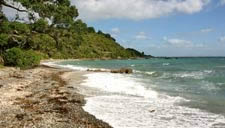
Dimdima
Online Children's Magazine from India

Dimdima
Online Children's Magazine from India

Rangitoto Island:
This is the largest & the youngest of Auckland's volcanoes. It is now extinct. The island is now managed by the Department of Conservation. Rangitoto became a public reserve in 1890. During the 1920s & 30s, prisoners built roads, trails & stone walls on the island. During the World War II, extensive defence installations were placed on the site. You can indulge in activities like swimming, fishing, walking, bird watching, nature study, walking up to the summit & many more things. Lava caves near the centre of the island are worth seeing. Although covered in basaltic lava, Rangitoto has the largest remaining of Pohutukawa forest in New Zealand. From downtown Auckland, you get ferries to reach to this place.
Motutapu Island:
It is about 8km north-east of Auckland. Joined to Rangitoto Island by a causeway, it is much older & different, geologically & botanically. There are many archaeological sites from early Maori occupation to recent European history. You can reach this place in a ferry.
Browns Island:
Browns Island or Motukorea is a small dot lying off Auckland�s eastern suburbs. Historic Maori pa sites, gardens & settlements cover the island. In 1840, Willam Brown bought it & established a pig farm with Dr John Logan Campbell. In 1956 Auckland businessman Sir Ernest Davis gave the island to the city. Motukorea is a popular picnic destination, but there are no visitor facilities on the island. No ferry services are available, but one can reach there by other means (small boats, kayak, etc).
Motuihe Island:
Motuihe is 16km from downtown Auckland & is a recreation reserve known for its sheltered sandy beaches, clear waters & excellent anchorages. Motuihe was extensively settled by Maori & then farmed by Europeans for over a century, the site of Auckland�s quarantine station for 50 yrs, a prisoner of war camp during the World War I & a naval training base. You can reach there by a ferry or a private boat.
Waiheke Island:
It lies around 17km off Auckland. Around 8000 people live on this island. This island has been home to various iwi for about a thousand yrs & there are more than 50 pa sites on the island. The name Waiheke means �cascading waters�. You can reach there by a ferry.
Tiritiri Matangi Island:
This is an open pests-free sanctuary for rare & endangered plant & animal species. You cannot bring pests, seeds or pets onto the island. The Kawerau-A-Maki tribe built the Pa Tiritiri Matangi which was destroyed during inter-tribal conflicts. In 1971, Tiritiri became a part of the Hauraki Gulf Maritime Park. Its 20m high lighthouse has guided ships into the Hauraki Gulf since 1865. Here you can see New Zealand�s rarest wildlife. You can take a ferry from downtown Auckland.
Kawau Island:
The Maori people lived here until 1840 & copper was mined here in the mid 19th cent. Governor Sir George Grey bought Kawau in 1862 & in 1977 it became a part of the Hauraki Gulf Maritime Park & is open to the public. You can get there from downtown Auckland.
Dimdima is the Sanskrit word for ‘drumbeat’. In olden days, victory in battle was heralded by the beat of drums or any important news to be conveyed to the people used to be accompanied with drumbeats.
Bharatiya Vidya Bhavan
K. M Munshi Marg,
Chowpatty, Mumbai - 400 007
email : editor@dimdima.com
Bharatiya Vidya Bhavan
505, Sane Guruji Marg,
Tardeo, Mumbai - 400 034
email : promo@dimdima.com
Dimdima.com, the Children's Website of Bharatiya Vidya Bhavan launched in 2000 and came out with a Printed version of Dimdima Magazine in 2004. At present the Printed Version have more than 35,000 subscribers from India and Abroad.